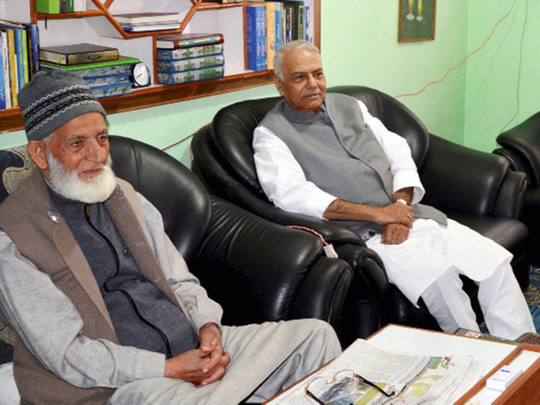
With no sign of the unrest in Indian Kashmir subsiding, the state is passing through one of the worst phases of its history. The scene has been made gloomier by the fact that both the Centre and the state government appear to be clueless about a solution.
Although Jammu and Kashmir Chief Minister Mehbooba Mufti believes that only five per cent of the people in the state are supporting the insurgency, she has been unable to rally the remaining 95 per cent in the government’s favour.
Her administrative inexperience and political timidity may be responsible for her seeming helplessness.
But, unfortunately, her coalition partner, the Bharatiya Janata Party (BJP), has also been unable to come out with ideas other than the use of strong-arm tactics — of which the pellet gun remains the primary weapon — to bring the situation under control. It must be noted that these guns, which can cause blindness, are not used anywhere else in India to control agitating mobs as, for instance, when the Jats went on a rampage in Haryana or when there was anti-Tamil violence in Bengaluru over the Cauvery water dispute between Karnataka and Tamil Nadu. If there is a feeling of alienation among the ordinary Kashmiris, it cannot but have been accentuated by such patent differences in crowd-control measures.
It is also undeniable that like the people of the northeast of India, the Kashmiris too are nowadays being looked at with mistrust for being “different”.
Quelling the turmoil in the Kashmir Valley should not be the only objective, therefore, of the government and civil society. There is also a need to reach out to the Kashmiri students and others who are studying and working in different parts of India.
However, winning hearts and minds does not appear to be high on the list of priorities of the Central Government as when the then prime minister, Atal Bihari Vajpayee, had spoken of insaniyat, or humaneness, while dealing with Kashmir.
Instead, the BJP leaders now seem to be guided by their customary hardline attitude, although there hasn’t been any talk recently of abrogating Article 370 (of the Constitution), which confers a special status on Kashmir.
In a belated attempt to douse the flames, Union Home Minister Rajnath Singh did visit the valley to mediate with the putative trouble-makers — the separatists of Hurriyat Conference. However, the latter showed no interest in having a dialogue with the all-party delegation that accompanied the home minister. Having succeeded in cornering the Centre and the state government, the separatists obviously saw no reason to come to their rescue.
But the situation is now taking a turn that is causing concern even to the Hurriyat. It is the burning of nearly 30 schools, including a 113-year-old institution in Anantnag district, which has made even hardliner Syed Ali Shah Geelani describe the arsonists as “enemies of the people of Kashmir”. It is possible that the Hurriyat has realised that the situation is going out of its hands, which is why it seems to be clueless about who the arsonists were.
The Lashkar-e-Taiba has been mentioned in this context, but whichever organisation is behind the incendiary attacks, what is a matter of deep concern is the surfacing of a certain brand of fundamentalism associated with the Taliban of the Afghanistan-Pakistan region, which is known for the attack on a Peshawar school in 2014 and the shooting of schoolgirl Malala Yousufzai (the Nobel Peace Prize winner), in 2012.
While the Taliban’s opposition to women’s education may have currently metamorphosed into a rejection of education in general, it is a pity that Kashmir should have become the venue of their depredations. It is sadly ironic that a state known for its association with the pluralistic concept of Kashmiriyat (the Kashmiri identity), should fall prey to such a vicious expression of hate.
Even if Geelani is today criticising the arsonists, he and the others in the Hurriyat cannot ignore the fact that it is their pursuit of a cruel medievalism that has encouraged fundamentalism to take root in the state at the expense of democratic norms. The burning of schools is only to be expected in such a negative atmosphere since a modern education system is anathema to the zealots. If the latter can ensure that a generation will grow up unlettered and untutored, it can be easily manipulated to not only throw stones at the police, but also swell the ranks of militants. Any failure to bring them to book will only make the conditions even more anarchic, turning the valley into a lawless tract.
As before, Kashmir remains a test case for the success of India’s multicultural ethos. But only large-scale investment, starting with the rebuilding of the burnt-out schools and creating widespread employment opportunities, can dispel misapprehensions about a hard-hearted Centre and bring the people in the valley closer to the rest of India.
— IANS
Amulya Ganguli is a political analyst.









